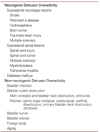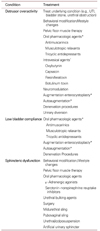Pharmacological Therapy for Urinary Incontinence
Article information
Abstract
Urinary incontinence is an important lower urinary tract symptom that negatively affects the quality of life. Urgency incontinence (UI) is urine loss accompanied by urgency, which is the chief complaint of overactive bladder (OAB) syndrome. OAB is defined as urgency, with or without UI, usually with frequency and nocturia. In contrast, stress urinary incontinence (SUI) involves involuntary urine leakage caused by a sudden increase in abdominal pressure. Treatment for urinary incontinence depends on the type of incontinence, the severity, and the underlying causes. Treatment options fall into four broad categories: lifestyle intervention, bladder retraining and/or pelvic floor muscle training, pharmacotherapy, and surgery. Pharmacotherapy is often the first-line therapy for OAB/UI, either alone or as an adjunct to various nonpharmacological therapies. Effectiveness of anticholinergic drugs for OAB/UI has been assessed in various observational and randomized controlled trials. Despite their side effects, anticholinergics are the first-line agents for UI. Tricyclic antidepressants have complex pharmacological actions such as anticholinergic, alpha adrenergic, antihistaminic, and local anesthetic properties. Recently approved anticholinergics, solifenacin and darifenacin, are selective M3 antagonists that may have tolerable side effects. Transdermal oxybutynin may offer comparable efficacy with oral formulation but lower side effects. In the absence of an effective and well tolerated drug for SUI, pharmacological therapy for this condition has remained in the off-label prescription of some products, particularly estrogens and α-adrenergic agonists. Duloxetine is the drug of choice specifically aimed at SUI. This article outlines the current state and future development in pharmacological therapy for urinary incontinence.








